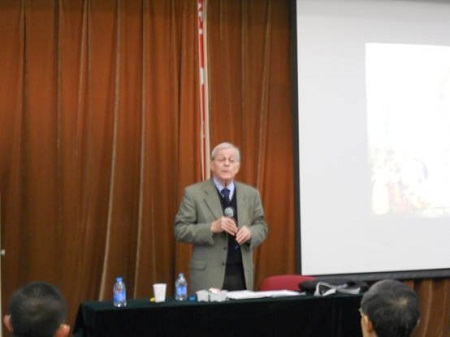Peking University, Nov. 9, 2012: “High Life & Low Life”, the exhibition of 18th-century western prints donated by Professor Donald Stone, had its opening in Peking University’s Arthur M. Sackler Museum of Art and Archaeology on Nov. 9th.
Wu Zhipan, Executive Vice-President of PKU, appreciated the kindness of Professor Stone donating his collection of prints to the Sackler Museum, which was the 6th time since his first donation in 2007.
“We have a rich collection of books here in PKU, but we don’t have a similar collection of art. A collection of western paintings in China is extremely rare. However, thanks to the generous donation by Professor Stone, those masterpieces that can only be seen in museums abroad are available here, which is of great convenience to our faculty and students,” said Professor Wu.
Professor Stone addressed the audience and presented his thanks to all who supported him and contributed to this exhibition.
“It was the best of times, it was the worst of times,” Charles Dickens wrote of late 18th-century Europe. For some people, life was very pleasant; for others, it was an age of severe hardship. As a newly emerging middle class developed, so did the desire for material comforts and fine arts to adorn their lives. In former times, only the nobility or religious orders could afford works of art. But, wih the invention of print-making, many people could now enjoy etchings made by (or copied from) famous painters such as French artists Antoine Watteau (1684-1721), Fran?ois Boucher (1703-1777), Jean-Baptiste Simeon Chardin (1699-1779), and Jean-Honore Fragonard (1732-1806). A group of distinguished print makers thus arose during the same era: Gilles Demarteau (1722-1776), Louis-Marin Bonnet (1736-1793), and many more. Some of them created beautiful color prints, which were intended to look like crayon drawings of watercolors.

Some of the greatest prints of the 18thcentury were made by painters in Italy and Spain by such artists as Giovanni Battista Tiepolo (1692-1770), Antonio Canaletto (1697-1768), and Francesco Goya (1746-1828). While creating works for noble clients as their principal source of income, they at the same time found in the etching technique a means of expressing their private thoughts and fantasies. By contrast, two popular artists–the Italian Giovanni Battista Piranesi (1720-1778) and the British William Hogarth (1697-1764)—made their livings by producing large folio-sized engravings for a wide audience. Piranesi provided visitors to Rome with unforgettabe images of the Eternal City, while Hogarth catered to the British taste for artworks that provided humor mixed with moral lessons.
The exhibition contains works by many celebrated western artists of the 18th century. Debucourt’s La Promenade Publique and Vauxhall Gardens by Thomas Rowlandson (1756-1827) are perhaps the two best-known etchings of the century. There are also works by wonderful artists who are not as well known, such as Jean-Jacques de Boissieu (1736-1810). The great print makers of the age have given us memorable images of the low life and the high life that existed in Europe just before the French Revolution in 1789, which some view as the start of modern history in the West.

Just before the opening ceremony, a lecture entitled “18th Century European Art and Life on the Eve of the French Revolution” was held by Professor Stone to give the audience an introduction to the collection and to give them further insight into the collection’s wonderful works.
Written by: Guo Caichen
Edited by: Alexandria Liu & Zhang Jiang